- Details
- Published on 26 August 2020
Vol. 640
6. Interstellar and circumstellar matter
First detection of 13CH in the interstellar medium
 The CH radical has long been recognized as a reliable proxy of molecular hydrogen in diffuse and translucent clouds. Its rare isotopolog $^{13}$CH, however, had been alluded to as a detection in the interstellar medium. In this paper, Jacob et.al present the detection of $^{13}$CH in absorption toward Sgr B2(M) and other galactic star-forming regions using the upGREAT receiver on board SOFIA. Combining these new data with previous observations of the main CH isotopolog toward the same sight lines, the authors have determined an improved estimate for the 12C^13 ratio as a function of the galactocentric distance.
The CH radical has long been recognized as a reliable proxy of molecular hydrogen in diffuse and translucent clouds. Its rare isotopolog $^{13}$CH, however, had been alluded to as a detection in the interstellar medium. In this paper, Jacob et.al present the detection of $^{13}$CH in absorption toward Sgr B2(M) and other galactic star-forming regions using the upGREAT receiver on board SOFIA. Combining these new data with previous observations of the main CH isotopolog toward the same sight lines, the authors have determined an improved estimate for the 12C^13 ratio as a function of the galactocentric distance.
- Details
- Published on 11 August 2020
Vol. 640
10. Planets and planetary systems
Masses for the seven planets in K2-32 and K2-233. Four diverse planets in resonant chain and the first young rocky worlds
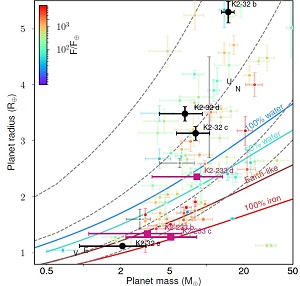 K2-32 and K2-233 are two planetary systems which host four and three planets, respectively. They were detected by the K2 mission transiting their host star. In this study, the authors measured their masses and bulk densities for the first time by using a long-term radial velocity follow-up with the HARPS instrument. K2-32 displays a similar architecture as our Solar System but in a scaled-down version, with a small rocky world in the inner regions, followed by a transitional sub-Saturn planet and two mini-Neptunes in the external region. All of them are in a compact resonant configuration inside half of Mercury’s orbit, which makes them key targets for atmospheric studies. With regard to K2-233, it is a young 600 Myr old star. Lillo-Box et al. confirmed in this study the rocky nature of the two inner planets in the system, thus representing the first instances of rocky worlds with measured masses around a young star. The two planets K2-233 b and c show masses and radii corresponding to a telluric composition. The results of this study allow for further investigations on the atmosphere of lower-mass planets, the early evolution of multi-planetary systems with rocky worlds, and the planet-planet interactions in compact multi-planetary systems in near resonant chains. The transiting nature of all of these planets and the precise bulk densities established in this work put them at the forefront of future atmospheric studies.
K2-32 and K2-233 are two planetary systems which host four and three planets, respectively. They were detected by the K2 mission transiting their host star. In this study, the authors measured their masses and bulk densities for the first time by using a long-term radial velocity follow-up with the HARPS instrument. K2-32 displays a similar architecture as our Solar System but in a scaled-down version, with a small rocky world in the inner regions, followed by a transitional sub-Saturn planet and two mini-Neptunes in the external region. All of them are in a compact resonant configuration inside half of Mercury’s orbit, which makes them key targets for atmospheric studies. With regard to K2-233, it is a young 600 Myr old star. Lillo-Box et al. confirmed in this study the rocky nature of the two inner planets in the system, thus representing the first instances of rocky worlds with measured masses around a young star. The two planets K2-233 b and c show masses and radii corresponding to a telluric composition. The results of this study allow for further investigations on the atmosphere of lower-mass planets, the early evolution of multi-planetary systems with rocky worlds, and the planet-planet interactions in compact multi-planetary systems in near resonant chains. The transiting nature of all of these planets and the precise bulk densities established in this work put them at the forefront of future atmospheric studies.
- Details
- Published on 28 July 2020
Vol. 640
1. Letters
Near-infrared emission lines trace the state-independent accretion disc wind of the black hole transient MAXI J1820+070
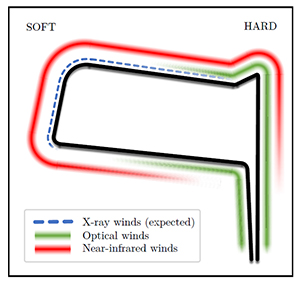
Blue-shifted absorption lines in the X-ray spectra of low mass X-ray binaries (LMXBs) provide the signature of hot winds from their accretion disk, carrying a sizable amount of material away. Cold winds also exist and are observed with the same characteristics in the optical spectra. Hot winds are preferentially observed during the "soft" state of LMXBs, when a disk is present and extends close to the compact object, dominating the X-ray spectrum. Cold winds are instead observed during the "hard" state when the standard accretion disk is pushed further out. Cold winds are revealed by blue-shifted lines in the optical spectra, mainly Hydrogen Balmer lines and He I (5976A). Here, Sánchez-Sierras and T. Muñoz-Darias monitored the evolution of the outburst from the black hole transient MAXI J1820+070 of which seven observations were taken with the X-shooter instrument at the ESO-VLT. These observations encompass the hard-soft-hard outburst evolution. Blue-shifted optical lines were previously observed in the "hard" state of MAXI J1820+070. The near-infrared (NIR) arm of X-shooter turned out to be particularly important on this topic: Blue-shifted Hydrogen Pashen and Brackett lines were observed during soft and hard states. The line shift is similar to what has been observed for optical lines. This result shows that NIR lines can be used to trace the cold wind across the entire LMXB outburst evolution and that cold winds are also present in the "soft" state.
- Details
- Published on 21 July 2020
Vol. 639
1. Letters
Broad-line type Ic SN 2020bvc. Signatures of an off-axis gamma-ray burst afterglow

Gamma-ray bursts (GRBs) are the brightest explosions in the Universe. There are two types of GRBs, and the long-duration ones are the outcome of the death of massive stars. A narrow, collimated jet pointing toward the Earth marks the GRB. At the same time, the star explodes giving rise to a supernova. GRBs that explode in the local Universe are almost always associated with broad-line, type Ic supernovae (i.e., those that were stripped more during the evolutionary path which brought them to explode). The supernova emission is isotropic and the GRB emission is collimated: We do expect that most of the type Ic supernovae lack a GRB, being that the Earth was missed by the jet. However, if we are just outside the GRB narrow jet, it is possible to observe an "orphan" GRB, that is to say a relativistic explosion without a high-energy signature. In this letter, Izzo et al. provide strong evidence for an off-axis GRB or choked jet (i.e., a jet which fails to break out from the star). This evidence comes from delayed X-ray emission - GRBs have a decaying X-ray afterglow and supernovae rarely have X-ray emission - and from the very high expansion velocity which is 20% of the speed of light, which were revealed from an early optical spectrum that was taken 1.5 d after the explosion. The off-axis viewing angle is ~25 degrees. The GRB barely missed the Earth and the authors were able to detect the X-ray emission thanks to its closeness of just 120 Mpc.
- Details
- Published on 08 July 2020
Vol. 639
6. Interstellar and circumstellar matter
Gap, shadows, spirals, and streamers: SPHERE observations of binary-disk interactions in GG Tauri A

A large fraction of stars are found in multiple systems. More than 4000 detections of extrasolar planets around single stars raise the question as to if and how planets in binary systems may form. Since protoplanetary disks are the birthplaces of planets, thus dictating the initial conditions, their characterization is crucial to understanding the planet formation process. Unlike single star systems, numerical simulations predict that the gravitational impact of the central binary will severely perturb its surrounding disk, leading to the formation of a gap through which material in the form of streamers will feed the central stars. New high-resolution scattered-light observations of GG Tau A, one of the most massive and largest circumbinary protoplanetary disks, reveal binary-disk interactions in unprecedented detail. The disk shows evidence of a large gap, several shadowed regions, spiral structures, as well as streamer-like filaments connecting the outer disk and the central binary. These filaments are possibly generated by periodic perturbations from the binary, tearing off material from the inner edge of the outer disk once per orbit as predicted by numerical simulations.
- Details
- Published on 03 July 2020
Vol. 639
7. Stellar structure and evolution
Observational appearance of rapidly rotating neutron stars. X-ray bursts, cooling tail method, and radius determination
There are several ongoing efforts to measure the neutron star equation of state. Various methods have been suggested to measure the neutron star mass and radius, including the cooling tail during "type I bursts", which occur when sufficient accreting matter deposits onto the neutron star surface, thus igniting the thermonuclear explosions. A specific spectral pattern is predicted due to the cooling neutron star surface, which can predict the neutron star radius with good accuracy. In this work, Suleimanov and colleagues compute the emission pattern for a rapidly rotating oblate (i.e., non-spherical) neutron star. This effect turns out to be important and overestimated by 3–3.5 km the neutron star radius (~30%).
- Details
- Published on 01 July 2020
Vol. 639
6. Interstellar and circumstellar matter
Molecular globules in the Veil bubble of Orion IRAM 30 m 12CO, 13CO, and C18O (2–1) expanded maps of Orion A
Expanding bubbles in Orion A: [C II] observations of M 42, M 43, and NGC 1977
Strong winds and ultraviolet (UV) radiation from O-type stars disrupt and ionize their molecular core birthplaces, sweeping up material into parsec-sized shells. The "Veil bubble" in Orion represents a nearby example of such a shell, where the complexities of stellar feedback can be studied in detail. The Veil lies in front of the well-known M42 HII region, and it is driven by the Trapezium-cluster stars. In such a harsh environment dominated by shocks and UV radiation, little molecular emission is expected to be found. As Goicoechea et al. show, however, some pockets of molecular gas have managed to survive in the Veil, and they have been detected with the IRAM 30 m telescope as small CO globules. These globules have small masses and are moderately dense, and they seem to be confined by the shell's external pressure and are likely supported by magnetic fields. They are either transient objects that formed by hydrodynamic instabilities or pre-existing over-dense structures of the original molecular cloud. In a companion paper, Pabst et al. analyze [CII]158 microns observations of the Veil and other nearby bubbles in Orion, which were carried out with the upGREAT instrument on board SOFIA. The Veil bubble is found to have an expansion time of 0.2 Myr and to be driven by the mechanical energy input from the wind of the O-type star θ1 Ori C, the most massive star in the Trapezium. Whereas the nearby bubbles associated with M43 and NGC 1977 are caused by the thermal expansion of the gas ionized by their central later-type less massive stars.
- Details
- Published on 26 June 2020
Vol. 638
2. Astrophysical processes
Fermi Large Area Telescope observations of the fast-dimming Crab Nebula in 60–600 MeV
The supernova that exploded in 1054 gave rise to the following well-known nebula since the manufacturing of large telescopes: the Crab Nebula, which is the first object in the Messier’s list of nebulae. The Crab Nebula is also one of the brightest objects in the X-ray sky; it consists of a pulsar at its center and a powered wind nebula. The Crab is a very stable object in X-rays and it has been used by astronomers to calibrate instruments since the dawn of X-ray astronomy. At very high energies (60-600 MeV), the Crab is known to produce bright gamma-ray flares at a rate of ~1 per year. In this paper, Yeung and Horns report the discovery of fast dimming in the 60-600 MeV flux from the Crab, observed by the Fermi Large Area Telescope. Typically, the Crab weakens by a factor of ~5 in a timescale of a few days and remains faint for several weeks. This fast variability lends support to models which ascribe to the inner knot of the Crab Nebula (a spot at ~0.3 arcsec from the pulsar itself and visible in Hubble Space telescope images) from which very high energy emission is observed from the Crab, arising as synchrotron emission.
- Details
- Published on 24 June 2020
Vol. 638
7. Stellar structure and evolution
An in-depth reanalysis of the alleged type Ia supernova progenitor Henize 2-428
The planetary nebula Hen 2-428 was reported in 2015 to have a double degenerate core with an orbital period of 4.2 hours and, more excitingly, a combined mass of 1.76Msun, which is above the Chandrasekhar mass limit. The period and the mass imply that the system should merge in 700 million years and trigger in a type Ia supernova event. Reindl et al. most recently carried out an in-depth reanalysis of the alleged type Ia progenitor. They show that blends of He II λ 5412 Angstrom with DIBs resulted in an overestimation of the previously reported mass. The new total mass of the double degenerates is 1.08 Msun, a measurement that no longer exceeds the Chandrasekhar mass limit.
- Details
- Published on 23 June 2020
Vol. 638
4. Extragalatic astronomy
The GOGREEN Survey: A deep stellar mass function of cluster galaxies at 1.0 < z < 1.4 and the complex nature of satellite quenching
The origin of the bimodality of galaxies that separates star-forming from passive galaxies remains incompletely understood. In particular, it is not clear whether the mechanisms at play in the present-day Universe can also explain how star-formation quenched in distant galaxies. To address this question, van den Burg et al. realized the most precise measurement of the stellar mass function of galaxies in the dense environment of 11 galaxy clusters at z=1 to 1.4 using photometric measurements from the blue to the 4.5 microns bands. Surprisingly, what they find is in stark contrast to what several studies concluded from the study of nearby galaxies. These studies refer to the following two mechanisms that act separately and independently in the local Universe: a mass-independent environmental quenching and an environment-independent mass quenching. When they compare the stellar mass functions of star-forming and passive galaxies in the clusters and in the field at z=1-1.4, the authors find no signature of purely mass-independent environmental quenching. Instead galaxies in clusters appear to quench through the same processes as those in the field, simply they do so at an earlier time. They conclude that galaxies that are destined to become part of z=1-1.4 clusters start their formation “early” with respect to galaxies in the field, but they quench via a similar physical process.
- Details
- Published on 15 June 2020
Vol. 638
1. Letters
Evidence for a rapid decrease of Pluto’s atmospheric pressure revealed by a stellar occultation in 2019
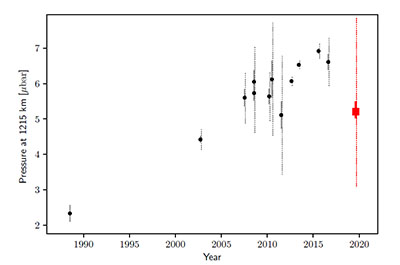
Pluto's atmosphere originates from sublimation-condensation equilibria of surface volatiles, primarily N2. Pluto's strongly elliptical orbit and high obliquity lead to marked seasonal variability of the local insolation. Regular monitoring of stellar occultations over the last 30 years has revealed that although Pluto has been receding from the Sun since 1989, its atmospheric pressure has increased by a factor of ~3 from 1988-2016. Based on climate models, this is best understood to be due to the evolution of insolation over Sputnik Planitia, the largest reservoir of N2 ice on Pluto, and models have predicted that the pressure should progressively decline after 2015, which is a consequence of the subsolar point moving to higher northern latitudes. Using a single-chord stellar occultation observed from Hawaii, Arimatsu et al. determine that Pluto's atmospheric pressure in 2019 was approximately 21% lower than it was in 2016. Although significant at 2.4 sigma only, this result! suggests that Pluto's long-expected atmospheric decline has started, and at a pace faster than anticipated by models, possibly pointing to additional regions of nitrogen ice deposition. Continuing the monitoring of Pluto's atmosphere is needed to confirm the trend and improve our understanding of Pluto's climate and its atmospheric sublimation-condensation cycles.
- Details
- Published on 09 June 2020
Vol. 638
10. Planets and planetary systems
Revised mass-radius relationships for water-rich rocky planets more irradiated than the runaway greenhouse limit
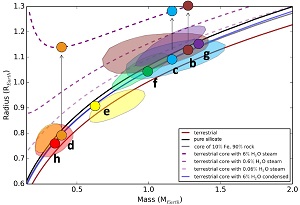
With seven rocky planets on temperate orbits, of which three are considered to be in the habitable zone, the TRAPPIST-1 system is one of the best characterized and fascinating planetary systems. Based on knowledge of their masses, radii, and densities, previous studies inferred that most of the seven planets are likely enriched in volatiles (e.g., water), up to tens of percent of the planetary masses. However, the three innermost planets (TRAPPIST-1b, c, and d) receive more irradiation from the star than the runaway greenhouse limit, implying that all of their putative water reservoir could actually form a steam atmosphere, and it has been shown in a recent study by Turbet et al. (2019) that this situation leads to strong atmospheric expansion. Here the authors apply these concepts to propose revised mass-radius relationships for this class of planets, providing, in particular, empirical formulas for the thickness of the H2O steam atmosphere as a function of planet core gravity and the radius, water content, and irradiation. For a given water-to-rock mass ratio, these new mass-radius relationships lead to planet bulk densities that are much lower than if water is assumed to be in its condensed form, implying that the latter assumption considerably overestimates the planets' bulk water endowment. The application to the TRAPPIST-1 system implies that when assuming a terrestrial core composition, TRAPPIST-1b, c, and d can accommodate a water mass fraction of 0.1-2 %, at most, and perhaps even much less.
- Details
- Published on 08 June 2020
Vol. 638
1. Letters
Unexpected late-time temperature increase observed in the two neutron star crust-cooling sources XTE J1701-462 and EXO 0748-676
During an X-ray outburst, a transient neutron star accretes matter which then heats the crust. After the outburst has ended, the neutron star cools, providing invaluable insights into the properties of the crust. Without further sources of heat, the compact object is expected to continue to cool. This simple physical picture is challenged by the observations presented in this Letter, in which a late time rise in temperature has been observed in two transient systems years after the outburst ended. As the authors have stated, this rise in temperature is unexplained. Further studies should lead to a deeper understanding of the dense matter physics.
- Details
- Published on 29 May 2020
Vol. 638
10. Planets and planetary systems
Mt. Wendelstein imaging of comet 41P/Tuttle-Giacobini-Kresak during the 2017 perihelion arc
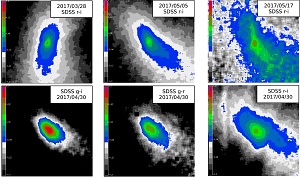
Comet 41P/Tuttle-Giacobini-Kresak (41P), a Jupiter family comet with three discoveries over about 100 years, is in a short-periodic orbit around the Sun with the perihelion close to the Earth distance. The 2017 apparition of 41P offered a long-lasting visibility of the comet at a close distance to Earth. The four month-long imaging campaign with the 2 m telescope at the Mount Wendelstein Observatory was aimed at characterizing dust activity and nucleus properties of the comet. Using a new analysis method of the inner coma flux, we derived a small mean equivalent radius of about 600 m for the nucleus with an unusual body axes ratio that is higher than two. The nucleus rotation axis was determined from the geometric appearance of coma structures, which were enhanced in the images. A long-lasting coma fan was produced by an extended region at high latitudes on the slowly rotating nucleus, whereas isolated jets originated from narrow, low latitude active regions on the nucleus. The dust activity of 41P, despite being difficult to quantify exactly because of an unknown phase function correction for the comet, indicates a steep radial profile that falls off with an increasing distance from the Sun. Colors and flux profiles provide evidence for dust fragmentation in the inner coma of the comet. A singular outburst event created various dust structures in the coma. The outburst came from an extended region on the nucleus and was due to either a landslide on the nucleus or a sudden material release from a subsurface pocket of volatile ice.
- Details
- Published on 19 May 2020
Vol. 637
4. Extragalactic astronomy
Liverpool-Maidanak monitoring of the Einstein Cross in 2006–2019. I. Light curves in the gVrRI optical bands and microlensing signatures
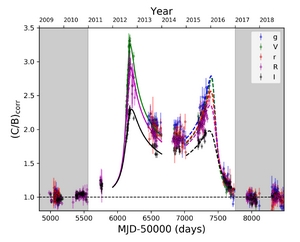 The Einstein Cross is a gravitationally lensed quasar at z= 1.695. The quasar QSO 2237+0305 is lensed in four images (A, B, C, and D) that are arranged like a cross around the nucleus of a nearly face-on spiral galaxy (the lens) at z =0.039. In addition to the global strong lensing, compact objects, such as stars, in the lensing galaxy produce microlensing and differential magnification of the four images. In order to gain more insight into these compact objects, the authors monitored the Einstein Cross using 4 374 optical frames (gVrRI) taken with the 2 m Liverpool and the 1.5 m Maidanak telescopes, over the 2006-2019 period, yielding light curves of the four images A-D. The differences between A-D light curves reveal strong microlensing signatures, affecting the C image, which experienced a double caustic crossing. The UV continuum of the quasar is modeled by a standard accretion disk of radius R, which increases with wavelength as a power law of exponent alpha=1.33. More monitoring data are required to draw a more robust conclusion.
The Einstein Cross is a gravitationally lensed quasar at z= 1.695. The quasar QSO 2237+0305 is lensed in four images (A, B, C, and D) that are arranged like a cross around the nucleus of a nearly face-on spiral galaxy (the lens) at z =0.039. In addition to the global strong lensing, compact objects, such as stars, in the lensing galaxy produce microlensing and differential magnification of the four images. In order to gain more insight into these compact objects, the authors monitored the Einstein Cross using 4 374 optical frames (gVrRI) taken with the 2 m Liverpool and the 1.5 m Maidanak telescopes, over the 2006-2019 period, yielding light curves of the four images A-D. The differences between A-D light curves reveal strong microlensing signatures, affecting the C image, which experienced a double caustic crossing. The UV continuum of the quasar is modeled by a standard accretion disk of radius R, which increases with wavelength as a power law of exponent alpha=1.33. More monitoring data are required to draw a more robust conclusion.
- Details
- Published on 28 April 2020
Vol. 637
4. Extragalactic astronomy
Tracing the anemic stellar halo of M101

Cosmological models of galaxy formation show that disk galaxies are embedded in extended stellar halos. However, previous studies of some disk galaxies have failed to detect this stellar component. This was the case of the prototypical disk galaxy M101, for which it has been suggested that it lacked this stellar halo component. In using optical imaging with the Hubble Space Telescope (HST), it is now possible to resolve M101 stars and map their halo out to 70 kpc from the center. The new color-magnitude diagrams reach down to two magnitudes fainter than the tip of the red giant branch (RBG). This allowed HST to trace the M101 halo component down to very faint surface brightness (μg ≈ 34 mag arcsec−1). The stellar population is found to be similar to that of metal-poor globular clusters in the Milky Way based on the mean color of the RGB stars. The HST star counts also allowed the authors to measure the total halo mass of M101, which is small in comparison to! Well studied galaxies, such as the Milky Way or M31. Indeed, the comparison with the other six galaxies from the same survey shows that M101 has an anemic stellar halo.
- Details
- Published on 22 April 2020
Vol. 636
15. Numerical methods and codes
Deep Horizon: A machine learning network that recovers accreting black hole parameters
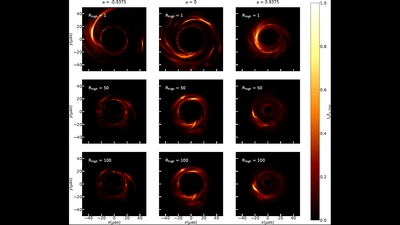
In April 2019, the Event Horizon Telescope released the first ever image of the shadow of a black hole at the center of the M87 elliptical galaxy, dominating the Virgo cluster. These observations were made possible by eight ground-based radio telescopes spread all over the world. In this paper, van der Gucht et al. present a combination of two neural network algorithms that are able to recover the physical parameters of the accreting black hole based on the observed shadow. To train these networks, they used a set of general relativistic simulations of accretion disks around massive black holes, testing a grid of parameters. They discover that with the current resolution, only the mass of the black hole and the mass accretion rate can be safely recovered. To derive further parameters, such as the black hole spin, we would need to go beyond the Earth-based set of radio telescopes and include a space-based radio mission.
- Details
- Published on 03 April 2020
Vol. 635
10. Planets and planetary systems
Is there NaI in the atmosphere of HD 209458b? Effect of the centre-to-limb variation and Rossiter-McLaughlin effect in transmission spectroscopy studies

HD209458b has a special status among exoplanets. It was the first one shown to transit in front of its star and the first one for which an atmospheric signature (atomic sodium) was reported from spectroscopy in 2002, which was seemingly confirmed in subsequent observations. Transit spectroscopy in which spectra in- and off-transit are rationed to extract the transmission spectrum of the planet's atmosphere is simple in its principle, but it may be fraught with complex effects. Those include the nonuniform brightness of the star (center-to-limb variations, CLV) and the Rossiter-McLaughlin (RM) effect in which the planet progressively occults regions of the star with different line-of-sight velocities, causing a shift in the stellar lines as the transit proceeds. In focusing on the sodium D lines in HD209458, Casasayas-Barris present a detailed modeling of these effects and demonstrate that, even the lack of any absorption by the planet's atmosphere, can lead to apparent spectral features in transmission spectroscopy. Most remarkably, calculations indicate that those features may predominantly show up in emission. By comparing model predictions to archival data from HARPS-N and CARMENES, they conclude that transmission spectra actually reveal no detectable Na I atmospheric absorption due to the planet. The study also provides a natural explanation for the Na I emission features seen in earlier HST/STIS observations of the system, which had been previously interpreted to be due to telluric contamination. More broadly, this work indicates the need for careful reassessment of some of the atmospheric identifications based on exoplanet transit spectroscopy.
- Details
- Published on 01 April 2020
Vol. 635
6. Interstellar and circumstellar matter
The origin of tail-like structures around protoplanetary disks

The origin of the enigmatic tail-like structures recently detected around the disks of several young stars was studied using numerical hydrodynamics simulations. Two possible formation mechanisms were considered: ejections of gaseous clumps from dynamically unstable protostellar disks and close encounters between quiescent protoplanetary disks and intruder stars. The authors demonstrate that ejected clumps produce a unique type of tail that is characterized by a bow-shock shape. Such tails originate from the supersonic motion of clumps ejected through the dense envelope that often surrounds young protostellar disks. On the other hand, close encounters between an intruder star and a protoplanetary disk produce three types of such tail-like structures. The authors define these as pre-collisional, post-collisional, and spiral tails. These tails can be distinguished from one another by particular features of the gas and dust flow in and around them. The estimated mass of gas and dust in the tail can amount to tens of Jovian and Earth masses, respectively, which is higher than what was inferred for similar structures in SU Aurigae and FU Orionis. The authors argue that tail-like structures around protostellar and protoplanetary disks can be used to infer interesting phenomena, such as clump ejection or close encounters. In particular, the bow-shock morphology of the tails could point to clump ejections as a possible formation mechanism.
- Details
- Published on 23 March 2020
Vol. 635
7. Stellar structure and evolution


